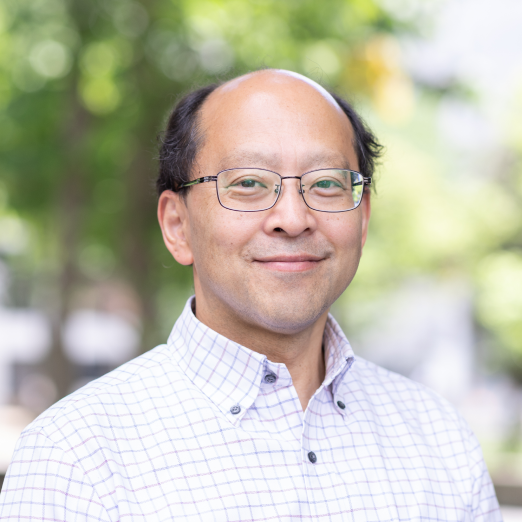
山田 章一 教授
Yamada, Shoichi
専門分野
理論宇宙物理学
宇宙の特異天体でミクロからマクロまで物理を理解する
研究テーマ
超新星爆発の機構 / 中性子星・ブラックホールの形成 / 天体からのニュートリノ・重力波放出 / 強磁場の物理 / 高温高密度物質におけるニュートリノの物理
キーワード
超新星, 中性子星, ブラックホール, ニュートリノ, 重力波, 強磁場, 大規模シミュレーション
LINKS
RESEARCH OVERVIEW
研究概要
宇宙には、地上では考えられないような高エネルギーの現象がたくさんあります。 私が主たる研究テーマとしている超新星もその一つです。 超新星は非常に明るい天体です。 銀河は100億個程度の星の集まりですが、超新星はそれ一つでこの銀河一つ分に匹敵する明るさを持っています。 爆発のエネルギーに直すと、太陽から地球が一年間に受けるエネルギーより、約20桁も大きなものになります。しかもこの莫大なエネルギーがわずか1秒以下という時間のうちに放出されます。 このような高エネルギー現象では、いろいろ地上では考えられないようなことが起こります。 神岡鉱山の観測装置スーパーカミオカンデでは太陽や宇宙線からくるニュートリノという素粒子を観測していますが、超新星は莫大な量のニュートリノを放出します。 事実、スーパカミオカンデの前身であるカミオカンデ観測器は、超新星1987Aから飛んで来たニュートリノを観測して一躍有名になり、小柴さんがノーベル賞を受賞しました。 ニュートリノが大量に存在する超新星の中心部では、ニュートリノの種類が互いに変換し合うニュートリノ振動という現象が複雑に起こると考えられています。また、超新星が起こった後には、中性子星やブラックホールといった、宇宙のいわゆるコンパクト高エネルギー天体が形成されると考えられており、超新星の研究はこうした興味深い天体の形成メカニズムを研究することにもなるわけです。
宇宙物理学のおもしろさは、地上で実現できないような極限的な状況のもとで、我々がこれまでに知り得た物理の理解が正しいかを確かめることができるということにあります。 超新星を研究することは、そのメカニズムを明らかにするだけでなく、そこで実現されているであろう高温、高密度、強重力場、強磁場を実験場として、我々の素粒子、原子核、重力理論等に対する理解が正しいかを確かめ、ニュートリノの質量の発見が実は太陽から放出されたニュートリノの観測を契機としていたように、あわよくば何か知らなかったことを見つけだそうという試みも含んでいます。
最近では、超新星以外にもいろいろな高エネルギー天体が注目をあつめています。 例えば、宇宙のあらゆる方向で等方的におこっているγ線バーストという現象では、大質量星の重力崩壊や中性子星同士の合体によるブラックホール形成が関係していると思われています。 これ以外にも、地上で最も強い磁石より10桁以上も強い磁場を持った中性子星が発見されるなど、高エネルギー天体物理学は今非常に面白い時期を迎えています。 自由な発想で色々なことを考えられるのが理論宇宙物理学の一つの魅力です。
MESSAGE to STUDENTS
学生へのメッセージ
宇宙は物理の宝庫です。宇宙には宇宙それ自身も含めて様々な天体があり、地上では実現が困難な物理状態が実現していると考えられます。そこで実際に何が起こっているのか、我々はそこから何を学べるのか、理論を頼りに考えるのは実に楽しいものです。君らが学んだ物理の基礎が全て役に立ちます。私たちの研究室は物理が好きな人の集まりです。自由なアイデアで物理をともに議論しましょう。
学歴・経歴
1987年 東京大学理学部物理/学科卒業
1992年 東京大学大学院理学系研究科 物理学専攻博士課程修了
1992年 日本学術振興会特別研究員
1993年 東京大学理学部物理学科助手
1995年 日本学術振興会海外特別研究員
2000年 大阪大学レーザー核融合研究センター助教授
2002年 早稲田大学理工学部物理学科助教授
2005年 早稲田大学理工学術院物理学科教授
現在に至る
所属学協会
- 日本物理学会
- 日本天文学会
- 国際天文連合

Yamada, Shoichi
Professor
Field of study
Theoretical Astrophysics
Understanding physics from microscopic to macroscopic scales with compact objects in the universe
Research Themes
mechanism of supernova explosions / formations of neutron star and black hole / emissions of neutrinos and gravitational waves / physics of very strong magnetic fields / neutrino physics in hot and dense matter
Keywords
Supernovae, neutron stars, black holes, neutrino, gravitational wave, strong magnetic fields, large-scale simulations
RESEARCH OVERVIEW
In the universe there are many phenomena of enormous energy that are just unrealizable in the laboratory on Earth. Supernovae, one of my main research subjects, are one of such phenomena. The supernova is very bright. In fact it is as bright as a galaxy, which consists normally of 10 billion stars. It is an explosion of a massive star, the energy of which is greater roughly by 20 orders than the energy emitted annually byt the sun. Moreover, this gigantic energy is released only in a second. In such high-energy conditions, a variety of intriguing things that are unthinkable in terrestrial settings can happen. For example, the supernova radiates a copious amount of neutrinos, one of the elementary particles. In fact, the late Prof. Koshiba observed them coming from SN1987A, a supernova in the Large Magellanic Cloud, with the Kamiokande neutrino detector, which is a predecessor of the Super-Kamiokande detector in current operation, and was awarded Nobel prize. In the central region of the supernova, the neutrinos are so dense that their species are supposed to be changed in a complex way, the phenomenon called collective neutrino oscillations. After the supernova explosion, either a neutron star or a black hole is formed. The supernova research is meant also to reveal these phenomena.
The nice thing with astrophysics is that we can study physics in extreme conditions that are difficult to generate on Earth. We may be able to find something that we could not in laboratory. We exploit high-energy astronomical events such as the supernova as an alternative to laboratory for the investigation not only of those events themselves but also of the physics that could be unveiled only in such high densities and/or high tempertures and strong gravity and magnetic fields.
These days there are many other high-energy astronomical objetcs attracting researchers. For instance, gamma-ray bursts, that occur isotropically in the universe, are believed to be associated with the black hole formations via massive-star collapse or neutron star merger. Magnetars are neutron stars with very strong magnetic fields, more than 10 orders of magnitude stronger than the strongest magnetic fields on Earth. We are witnessing the opening of a new era of astrophysics. We can enjoy it with our own new ideas.
MESSAGE to STUDENTS
The universe is a treasure box of physics. There are a rich variety of objetcs including the universe itself, presenting their unique physical environments. It is a great fun to think theoretically over what they are, what is going on in them and what insights we can gain from them. In so doing, everything you ar e currently learning in the undergraduate school will be useful. Our laboratory welcomes those young students who love physics. Let us discuss whatever in physics, bringing together new ideas.
Education and Career
EDUCATION
1987 Bachelor of Science, University of Tokyo, School of Science, Department of Physics
1989 Master of Sience, University of Tokyo, School of Science, Department of Physics
1992 Ph.D. University of Tokyo, School of Science, Department of Physics
RESEARCH EXPERIENCE
April 1992 – March 1993 JSPS Research Fellow, University of Tokyo
April 1993 – August 2000 Research Associate, University of Tokyo, Schools of Science, Department of Physics
August 1995 – August 1997 JSPS Overseas Research Fellow, Max-Planck Institut fuer Astrophysik, Garching, Germany
August 1997 – March 1998 Guest Scientist, Max-Planck Institut fuer Astrophysik, Garching, Germany
August 2000 – August 2002 Associate Professor, Institute of Laser Engineering, Osaka University
August 2002 – April 2005 Associate Professor, Waseda University, Schools of Science & Engineering, Department of Physics
April 2005 – present Professor, Waseda University, Schools of Science & Engineering, Department of Physics
Professional Memberships
- The Physical Society of Japan
- Astronomical Society of Japan
- International Astronmical Union
